 Image search results - "biwako" Image search results - "biwako" |

Three-day (Aug. 9-11, 2006) rowing route around the southern half of the lake by the Kyoto Univ. rowing club.1st day: Home base in Seta River to Manohama (crew change), then to Omi-Maiko.
2nd day: Omi-Maiko to Manohama, then to Chomeiji.
3rd day: Chomeiji to Manohama where crew changes. Then to home base in Seta River.
|
|

Three boats are used for the trip, sighted here off shore near JR Hira Station on the Kosei Line. 湖西線比良駅の沖
|
|
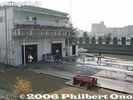
Seta Rowing Club's 2-story clubhouse located in Otsu, Shiga Prefecture. The club is a registered NPO. The club is named after Seta River at the southern tip of Lake Biwa. Regattas are also held on the river, Lake Biwa's sole outflowing river.
|
|

Lake Biwa is near the center of Honshu island between Nagoya and Kyoto.
|
|

Being my first regatta, I was at first daunted by the rowing terminology for the different types of boats.
|
|

Arriving Omi-Maiko on Day 1. Rowing around the lake has been an annual tradition.
|
|
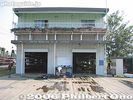
Seta Rowing Club's clubhouse. Boats are stored on the bottom floor, while the 2nd floor has office space, ergo machines, meeting room, locker room, etc. Web site here
|
|

Carrying back a single sculling boat
|
|
|
|
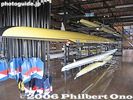
Oars and boats stored on the bottom floor. The club offers 2-hour rowing lessons on Sundays during May to Nov. Address: 6-1 Ogaya, Otsu, Shiga 520-2144 Japan. Phone/Fax: 077-545-9961, Email: info@setarc.jp
|
|

The place was not as crowded as you would think.
|
|

They use four-man boats (called "knuckle four" in Japanese) with sliding seats. It is stable and safe, ideal for beginners.
|
|

Many boats are made in Italy.
|
|

To mark the song's 100th anniversary, a new song monument was unveiled at Kyoto University (Yoshida-South Campus) on Nov. 25, 2017.
|
|

Rowing team from Nagahama
|
|

Each boat has four rowers and cox who steers the rudder.
|
|
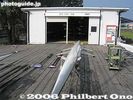
Right across the clubhouse is the Annex boat house.
|
|

Front side of the monument has the Japanese lyrics and explanation of the song. Monument is made of stainless steel with a brushed-metal finish.
|
|

The green boat. 近江舞子上陸
|
|
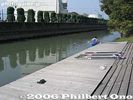
Club's boat dock. This narrow canal leads to Lake Biwa.
|
|
|
|

Azaleas in full bloom along the lake edge
|
|

The boats are wooden, and a few decades old.
|
|
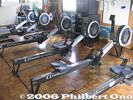
Rowing exercise machines called "ergometers" or "ergo" or "indoor rower." In Japan, they call it "ergo." エルゴThe machine measures the energy you expend rowing. Also measures how fast and far you rowed if you were on water. They even have ergo rowing contests which is a sport itself.
|
|
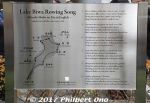
Monument's English side has a bilingual Lake Biwa map and Lake Biwa Rowing Song English lyrics.Directions: From JR Kyoto Station's Karasuma side (north side with Kyoto Tower), go to bus stop D2 and catch the No. 206 bus bound for "Gion Via Kiyomizu-dera Temple/Kitaoji Station" (三十三間堂・清水寺・祇園・百万遍). The bus leaves every 15 min. or so (bus schedule here), but it can be very crowded. The ride takes abut 30 min. Get off at "Kyodai Seimon-mae" (京大正門前). Cross the big road (Higashi-Oji-dori) and walk along Higashi-Ichijo street. The main Yoshida Campus will be on the left while the Yoshida-Minami Campus will be on the right. Enter the Yoshida-Minami Campus and walk to the central courtyard area.
(From Kyoto Station, there is also an express bus (京大快速) to Kyoto University Hospital from bus stop D3, but it runs only at certain times on weekdays, mainly in the morning and mid-afternoon (bus schedule here).
|
|
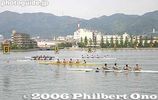
Four-man boat race. There were also foreign rowers from international schools.
|
|

Notice the rudder. Controlled by a pair of strings held by the cox.
|
|
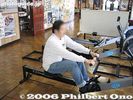
The rowing lesson starts with an ergo workout.
|
|

Cheering section for Nagahama
|
|

Beachgoers frolick in the lake as the rowing boats arrive.
|
|

Carrying the boat.
|
|

About the song and rowing route... この歌について(日本語解説)Shiga Prefecture's most famous and beloved song is called Biwako Shuko no Uta (琵琶湖周航の歌) or "Lake Biwa Rowing Song." I have rendered this song into both pictures and English, according to my own imagination and interpretation.
Please see this page for a full explanation: https://photoguide.jp/txt/Lake_Biwa_Rowing_Song
First composed in 1917 by a bunch of college students from Kyoto, the song has been recorded by many famous Japanese singers and groups. In 1971, it became a major nationwide hit with singer Tokiko Kato's rendition. Today, the song remains a favorite among choir groups in Japan, and a choir singing contest is held for the song every June (since 1997) in Imazu, the birthplace of the song in the northwestern corner of Lake Biwa.
Shiga Prefecture also has stone monuments dedicated to each of the six verses. There's even a museum (Biwako Shuko no Uta Shiryokan) in Imazu dedicated to the song. Okaya city on the shores of Lake Suwa in Nagano Prefecture, the birthplace of the song's composer, Taro Oguchi (小口太郎) (1897-1924), also has a song monument and bronze statue of him.
|
|

Four-man race with the cox at the stern
|
|

Verse 1 Song Monument, Otsu (Mihogasaki). In 1973, this was the first monument built for the song. The song's first and most famous line, "Ware wa Umi no Ko" is written. 一番の歌碑。大津市三保ケ崎。This monument is near the boat house in Mihogasaki, a stone's throw from Hama-Otsu.
われは湖の子 さすらいの
旅にしあれば しみじみと
のぼる狭霧や さざなみの
志賀の都よ いざさらば
Ware wa Umi no Ko, sasurai no
tabi ni shiareba, shimijimi to
Noboru sagiri ya, sazanami no
Shiga no Miyako yo, iza saraba
|
|

On June 16, 2007, Imazu marked the 90th anniversary of the song by organizing a boat cruise on Lake Biwa and other events. Omi-Imazu Station had a sign directing guests to Imazu Port. 90周年の記念「琵琶湖周航クルーズ」の近江今津駅内
|
|

The orange boat. On the left at the ear is the cox, the middle are four rowers, and at the front of the boat is one extra person who can rest and enjoy the ride.
|
|
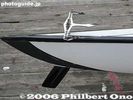
Sleek rudder and steering cables
|
|

Canora Hall, venue for the Okaya International Exchange Association's 15th anniversary festival.
|
|

Front of Yoshida Chiaki's home in Niigata (formerly Niitsu) which I visited in Nov. 2007. Yoshida Chiaki composed a song called "Hitsuji-gusa" (Water Lilies) whose melody was used for the song "Biwako Shuko no Uta" (Lake Biwa Rowi
|
|

Starting line. The man says "Yoi" (Ready) then "Go."「用意」、次いで「ゴー」
|
|

Imazu Port. A large crowd of people waiting to board the chartered boat for a 3-hour cruise on Lake Biwa to commemorate the 90th anniversary of the song, Biwako Shuko no Uta.
|
|

Most people were oblivious to the boats.
|
|
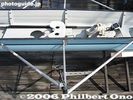
Rowing seat with moving seat on rails, fixed shoes, and outrigger for the oar.
|
|
|
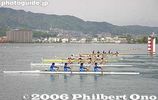
Four-man race starts with the cox at the front.
|
|

The photo above shows part of the stone monument for the first verse of the song. It reads "Ware wa Umi no Ko" (We're children of the lake). [url=http://photoguide.jp/txt/Lake_Biwa_Rowing_Song]More info about Lake Biwa Rowing Song here.[/uThis is the song's first and most famous line. The monument is in a small park near the former boathouse in Mihogasaki pier. The photo has been digitally altered (the colors are not real).
I visited and photographed all the places mentioned in the song as well as all the song monuments in Otsu, Omi-Maiko, Imazu, Chikubushima, Hikone, Chomeiji, and Okaya (Nagano). I also created some digital images to match the scenes mentioned in the song.
|
|

The "Rio Grande" cruise boat awaits at Imazu Port on a miraculously sunny day during the rainy season. 梅雨でありながら、奇跡的にこんないい天気になった。今津港
|
|

Carrying the boat to water.
|
|

Front gate of Yoshida Chiaki's home
|
|

Off they go
|
|

Reception desk for passengers. A little over 100 people joined the cruise. クルーズの受付
|
|

The orange boat decided to go ashore where it was less crowded.
|
|
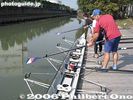
Inserting the oars into the outriggers.
|
|

Inner garden. I met Yoshida Yuki (吉田ゆき), the niece of Yoshida Chiaki who showed me the house and a few materials. Flowers planted by Chiaki still grow in the garden.
|
|
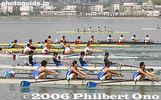
Close-up of rowers at Asahi Regatta
|
|

"Umi no Ko" (Child of the Lake) Lake Biwa training boatThe bow of Shiga Prefecture's "floating school." The name of this boat was obviously taken from the song. The boat is owned by Shiga Prefecture and used to educate elementary school kids about the lake. Since 1983, this ship has been serving as a floating school for kids where they stay overnight and spend two days conducting experiments to learn more about the lake. Picture was taken at Hikone Port.
|
|

Back of Verse 1 Song Monument, Otsu (Mihogasaki)Directions: From JR Otsu Station, take a bus to Mihogasaki. It's about 10 min. Or you can easily walk it from Hama-Otsu Station. Just walk on the main road toward the race boat arena. There will be a small marina on the right. Right after passing the marina, turn right into the small road. There will be a small park on the right. The monument is there. There are two stone monuments. It might be roped off and you're not supposed to enter the park. While you're there, walk around the marina and see the boathouse with the cherry blossom logo with three stripes. That's the logo of the school and the place where the boys left for the rowing trip in 1917. Otsu Station also has a tourist information office where you can obtain directions and a map.
|
|

Boarding time at Imazu Port. In the forefront is a song monument for Biwako Shuko no Uta.
|
|

Two boats will lie here overnight.
|
|
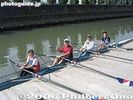
Ready to row on a "quad" sculling race boat. Each person rows with two oars.Sorry for the small image.
|
|

Yoshida Chiaki's room on the 2nd floor.
|
|

Cheering section
|
|

Megan and Jamie Thompson about to board the boat. トンプソン姉妹
|
|

Dark Blue Blades, symbol of the Kyoto Univ. rowing club.
|
|
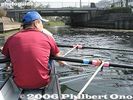
We now enter Lake Biwa.
|
|

Yoshida Chiaki's room on the 2nd floor. This is where he spent his final days while stricken with tuberculosis.
|
|

High school spectators near the finish line
|
|

"Umi no Ko" (Child of the Lake) Lake Biwa training boat for kids
|
|

Near the Verse 1 Song Monument is another stone monument engraved with the words of the entire song.
|
|

Boat name "Rio Grande" operated by Biwako Kisen. Named after Shiga's sister state in Brazil. There is also the "Michigan" paddlewheel boat named after Shiga's sister state in the USA.
|
|

Oars and boats
|
|
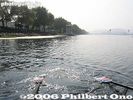
Lake Biwa Rowing Course operated by Shiga Prefecture for major rowing regattas. It is near the head of Seta River, and very near Seta Rowing Club.
|
|

Lake Biwa Rowing Song (Biwako Shuko no Uta) exhibition panel by Philbert Ono at Okaya, Nagano.
|
|

View from Yoshida Chiaki's room on the 2nd floor. Sometimes they receive local school children for tours of the house.
|
|

Kyoto University's cheering section for the 8-man raceComplete with cheerleaders.
|
|

Inside the front of the Rio Grande boat. 琵琶湖周航クルージング
|
|

Day 3: Arrival at Manohama beach, near the west end of Biwako Ohashi Bridge. 真野浜上陸
|
|
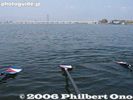
Oars keep the unstable boat stable.
|
|

Lake Biwa Rowing Song Exhibition panels. 「琵琶湖周航の歌」英語版の展示コーナー
|
|

Stairs from Yoshida Chiaki's room on the 2nd floor.
|
|

Eight-man race
|
|

Small park where the Verse 1 monument is located.This monument is near the boat house in Mihogasaki, a stone's throw from Hama-Otsu. It was built in 1973 as the first monument for the song.
This little park is actually off-limits and you're not supposed to enter it, for some reason. On the left side of the picture is another stone monument hidden by brush. It is engraved with the entire song. In the background, you can see the roof of the boathouse.
|
|

Open deck at the rear. The boat departed at about 11:30 am.
|
|

Manohama is where they change boat crews. Half of the people ride on bicycles on shore, while the other half row on 3 boats.
|
|

The oar handles overlap when you pull them. Often my hands bumped into each other.
|
|

Original copy of the magazine "Ongaku-kai" (The Musical Japan) where Yoshida Chiaki's song "Hitsuji-gusa" was first published and made popular. Issued in Aug. 1915. 音楽界
|
|
|

We passed by various scenic spots such as Shirahige Shrine, noted for the torii gate in the lake.
|
|

Landed in fishing lines.
|
|

Shoes are fixed to a small, angled platform.
|
|

Table of Contents of magazine "Ongaku-kai" (The Musical Japan) 音楽界. Many music-related articles.
|
|

Water intake for Lake Biwa Canal No. 2. Near Mihogasaki in Otsu, and adjacent to the boat racing arena.
|
|

Kyoto Univ. comes in 3rd place
|
|

Shirahige Shrine 白髭神社
|
|

Departing Manohama at about 11:30 am. 真野浜出発
|
|

On the first page is Yoshida Chiaki's song "Hitsuji-gusa" (Water Lilies) which was acclaimed enough to be published here.
|
|
|
|

Misty Horikiri Port in Omi-Hachiman. Boats leave here for Okishima island, Lake Biwa's largest island.
|
|
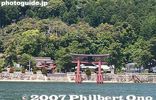
Shirahige Shrine torii as seen from the cruise boat.
|
|

Small motorboat which accompanies the three rowing boats. I was aboard this motorboat and took pictures.
|
|
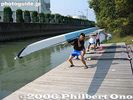
After a neat rowing trip, the boat is lifted out of the water.
|
|

On the first page is Yoshida Chiaki's song "Hitsuji-gusa" (Water Lilies). Although the melody is different, the lyrics are a direct translation of a childen's song called Water Lilies written by E.R.B. in the UK.
|
|

Starting line staff
|
|

Omi-Maiko with green pines on white sands. 近江舞子の「松は緑に 砂白き」
|
|

Biwako Ohashi Bridge 琵琶湖大橋
|
|

Rinsing the shell with fresh water.
|
|

Small book titled "A Garland of Flower-Poems" published in Japan. This was owned by Yoshida Chiaki and it includes the UK song "Water Lilies."
|
|

Starting line
|
|

Boat for Okinoshima at Horikiri Port
|
|

Omi-Maiko appears in the song.
|
|

Ferris wheel from the Biwako Tower amusement park, now defunct. 琵琶湖タワー(廃墟)
|
|

The boat is pencil-thin.
|
|

Page where "Water Lilies" is printed in the book. It is very likely that Chiaki found the song in this book, and decided to make his Japanese version. His signature is on the back of the book.
|
|

Waving the signal flag at a checkpoint to staff on shore.
|
|
|

Rolling with the waves
|
|

Rinsing the oars.
|
|
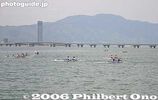
Two-man boat race
|
|
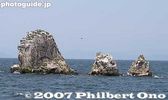
Okino-shiraishi Rocks, a favorite resting place for birds which turned the rocks white from bird droppings. Four rocks stand 80 meters deep in the lake. Out of the water, the tallest stands 14 meters high. 沖の白石
|
|

South of Biwako Ohashi Bridge.
|
|
|
|

Cheering/coaching from bicycle
|
|

So what does "Coral shrine" mean in the song? (There's no coral in the lake.) "I think it just refers to a beautiful place..." 「珊瑚の宮」はどういう意味?
|
|

Rowing past the Ukimido Floating Temple in Katata. 堅田 浮御堂(近江八景)
|
|
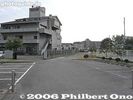
Entrance and road to the rowing clubhouse
|
|

Cheering/coaching on foot
|
|

We landed on Chikubushima for about an hour. Jamie and Megan also sang in English in front of the Verse 4 song monument.
|
|

Ukimido Floating Temple, one of the Eight Views of Omi (Omi Hakkei). 堅田 浮御堂(近江八景)
|
|
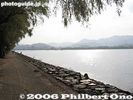
Near the rowing club is the Lake Biwa Rowing Course where regattas are held. 滋賀県立琵琶湖漕艇場
|
|

In Okaya, Nagano, Nakamura Naoko singing "Lake Biwa Rowing Song." This is the first time this English version was sung in public outside Shiga Prefecture.
|
|
|

Jamie and Megan Thompson sing in English in front of the Verse 4 song monument, Chikubushima. Next time we need to have an amplifier.
|
|

Mt. Hiei 比叡山
|
|

Nakamura Naoko singing "Lake Biwa Rowing Song." The first Japanese person to sing the song in public. 「琵琶湖周航の歌」の英語版も歌われた。
|
|

Awards ceremony
|
|

Jamie and Megan Thompson sing in English in front of the Verse 4 song monument, Chikubushima. They sang up to Verse 4. ジェイミーとメゲン・トンプソン姉妹が歌う
|
|

Omi-Fuji (Mt. Mikami) and Karasuma Peninsula. 近江富士(三上山)と烏丸半島
|
|

Nakamura Naoko singing "Lake Biwa Rowing Song" up to verse 3. 中村直子さんが三番まで歌われた。
|
|
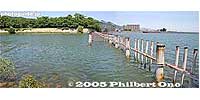
Water intake for Lake Biwa Canal No. 2. The Lake Biwa Canal (Biwako Sosui) supplies water from Lake Biwa in Otsu to Kyoto. After four years of monumental construction, the canal was completed in 1890.
|
|

Verse 2 Song Monument, Omi-Maiko (Omatsu). On the lake shore in Omi-Maiko (Omatsu) behind Hotel Biwa Lake Otsuka. Built in March 1989. 二番の歌碑。近江舞子(ホテル琵琶レイクオーツカの前)Pine trees are very green, on sands very white.
Omatsugasato is, a young maiden's home.
Bush of red camellia, hides her teary face.
She's weeping o'er a lost love, much too short to last.
Matsu wa midori ni, suna shiroki
Omatsugasato no, otomego wa
Akai tsubaki no, morikage ni
Hakanai koi ni, naku toka ya
松は緑に 砂白き
雄松が里の 乙女子は
赤い椿の 森蔭に
|
|

YouTube video of the song Hitsuji-gusa (Water Lilies) by a choir called Koai Gassho no Kai (小合合唱の会) performing at a memorial gathering on the anniversary of Chiaki’s death in Feb. 2013 at Chiaki’s birth home.Video uploaded by Ichii Yasuzo in Niigata.
|
|

Boat landing
|
|

Mihogasaki harbor, Otsu. The arrow points to the boat house where Oguchi Taro and crew departed for their rowing trips.Mihogasaki is accessible by bus from Otsu Station. Or just walk west from Hama-Otsu. This is also where water from the lake is drawn into the Biwako Canal's first canal which feeds water to Kyoto.
|
|

Old photo of Verse 2 Song Monument in Omi-Maiko. The tree was cut down and lyrics later painted white.
|
|

The man holds the 90th Anniversary tour sign as a guide for the tour guests.
|
|

She is the cox sitting at the rear and controlling the rudder with a pair of strings. コックス
|
|
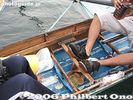
Lots of putty line the seams.
|
|
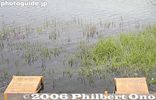
Temporary boat landing
|
|

Getting back on the boat. Little over a hundred people came on this cruise. If people knew it was gonna be such a beautiful day during this rainy season, more would have certainly come.
|
|

Verse 2 monument is on the lake shore, in front of Hotel Biwa Lake Otsuka, near what appears to be a boat pier. Short walk from Omi-Maiko Station.Directions: Near Omi-Maiko Station on the JR Kosei Line. After exiting the station, walk left toward Kitahama. Then get to the lake shore and walk along the lakeshore road until you see the monument under a large tree right on the shore. It is in front of Hotel Biwa Lake Otsuka.
|
|

Carrying the boat back
|
|

Entering Okinoshima Port. Okishima is the largest island in Lake Biwa. MAP
|
|

Mihogasaki harbor, Otsu. The arrow points to the boat house.
|
|

Sachiko Tsuji, the MC, interviews the sisters before they sang on the boat. 自動販売機前でインタービュー。船内の客は姉妹の顔や姿がほとんど見えへん。
|
|

Torii on shore (Hiyoshi Taisha Shrine) near Sakamoto. 鳥居
|
|

Jamie and Megan Thompson sing in English while cruising on Lake Biwa. 船の真ん中で歌って自動販売機がバックになって最悪。客に背中を向くばかりで申し訳ない。船の一番前に歌いたいと頼んだけど...
|
|

Otsu Prince Hotel in the distance.
|
|

Across the road from the Verse 2 song monument is this small music box. Press the button and you can hear the song play (sung by Kato Tokiko).
|
|

Side of boat
|
|

Boat house where Taro Oguchi and crew departed on their rowing trip. No longer used by the university's boat club. Mihogasaki, Otsu
|
|

After they sang, there was a mad rush to buy the CD priced at 800 yen. 英語版CDの購入者が殺到。
|
|

Cooling off
|
|

Then they signed autographs on the CD. CDのサインを求める。
|
|

Karasaki Pine Tree (One of the Eight Views of Omi or Omi Hakkei) as seen from Lake Biwa. 唐崎の松(近江八景)
|
|
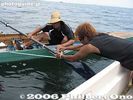
Making repairs. The boats are decades old.
|
|

Verse 1 Lyrics (Otsu) 一番の英訳(大津). School logo on boat house, a cherry blossom with three stripes for Dai-san Koto Gakko.We're children of the lake, off to wander 'round.
This journey fills my heart with, intense happiness.
Rising mist evaporates, ripples come and go.
Shiga's Miyako dear, bid farewell for now.
われは湖の子 さすらいの
旅にしあれば しみじみと
のぼる狭霧や さざなみの
志賀の都よ いざさらば
Ware wa Umi no Ko, sasurai no
tabi ni shiareba, shimijimi to
Noboru sagiri ya, sazanami no
Shiga no Miyako yo, iza saraba
--
This first verse refers to the start of the journey of life. The lake mist symbolizes the uncertainty of what lies ahead.
The capital of Shiga is Otsu, where they departed from Mihogasaki boat harbor on June 27, 1917. For some reason, the kanji characters for "Shiga" is incorrect for Shiga Prefecture.
|
|

More autographs. 姉妹はやはり人気者。
|
|

Okishima Port
|
|
|
|

Mixing with sailboats.
|
|

"Rising mist evaporates, ripples come and go." のぼる狭霧や さざなみの
|
|

Water lilies. The melody of the song originally came from a song called "Hitsuji-gusa" which means water lilies.
|
|
|
|

Water lily (Hitsuji-gusa). ひつじぐさ
|
|

Near miss?
|
|

Water intake for Lake Biwa Canal No. 2
|
|

Reeds bid rowers farewell for now...
|
|

After the boat cruise, there was a walking tour of Imazu. A special exhibition was held at the local community center in Imazu. 「周航の物語展」今津東コミセン
|
|

Fireworks platform for the Biwako Fireworks that night.
|
|

Sleek racing row boats and traditional yakata picnic boats on upper right
|
|

「周航の物語展」今津東コミセン
|
|

Rowing off central Otsu. 大津
|
|

Rear of boat house, now used by a private boat club.
|
|

This showcase showed things from the old Daisan Koto Gakko college.
|
|

Michigan paddlewheel boat. ミシガン
|
|

Student uniform for Daisan Koto Gakko school.
|
|

Michigan
|
|

Daisan Koto Gakko Rowing club towel
|
|

Toward Omi Ohashi Bridge. 近江大橋
|
|

Daisan Koto Gakko book of songs
|
|

The boat is deluged with large swells spilling into the boat. 大波
|
|

Race course at the head of Seta River where it meets Lake Biwa. 1000-meter course with 6 lanes.
|
|

Chojiya ryokan along the lake shore. Likely this is where Oguchi Taro and crew stayed. 丁子屋という旅館
|
|

Taking out the water.
|
|

Inside Chojiya. Very impressive Japanese-style inn with lake views.
|
|

Omi Ohashi Bridge
|
|

Room in Chojiya ryokan.
|
|

Zeze Castle ruins 膳所城跡
|
|

Inside Chojiya. The inn is famous for serving duck.
|
|

Removing weeds caught on the oars.
|
|

Water intake for Lake Biwa Canal No. 2
|
|

Another local landmark was this former bank building designed by William Merrell Vories who designed many buildings in Shiga, especially in Omi-Hachiman.
|
|

JR train tracks (Biwako/Tokaido Line)
|
|

Verse 3 Song Monument, Imazu. A lantern, at the end of the pier at Imazu Port. 三番の歌碑。今津港の桟橋。夜に赤く点灯。This is at the end of Imazu Pier. At night, this lamp lights up in red. You can see Chikubushima island and Mt. Ibuki in the background.
|
|

Leaving Okinoshima (we'll be back).
|
|

Inside former bank building.
|
|

Seta Karahashi Bridge on Seta River. 瀬田唐橋
|
|

Verse 3 Song Monument
|
|

In the evening during 5 pm-6:30pm, a slide show lecture about Oguchi Taro and Yoshida Chiaki was given by Iida Tadayoshi, a song researcher. Held at a hotel in Imazu. 歌と映像でつづる「小口太郎と吉田千秋の物語」講演会
|
|

Home base. The gray concrete building is their boathouse.
|
|

German-made accordian used by Yoshida Chiaki was also on display.
|
|

The last boat arrives.
|
|

View of Imazu shore from hotel
|
|

Lots of water drained out when the boat was turned over.
|
|

A reception was held afterward in the hotel. The mayor of Takashima, Hidekazu Kaito, speaks. I gave him a copy of our CD. 高島市長 海東英和
|
|

The boats are stored outside since there is no room inside the boathouse which stores the most expensive boats.
|
|

Verse 3 Song Monument is written with Verse 3.We drift from wave to wave, straying aimlessly.
On shore we see red fire, brings back memories.
With our sights set nowhere, rolling with the waves.
Today is Imazu or, Nagahama huh.
Nami no mani mani, tadayoeba
Akai tomaribi, natsukashimi
Yukue sadamenu, nami makura
Kyo wa Imazu ka, Nagahama ka
浪のまにまに 漂えば
赤い泊火 懐かしみ
行方定めぬ 浪枕
今日は今津か 長浜か
|
|

Interestingly, the mayor's first name "Hidekazu" means "English-Japanese." The next day, at the choir contest, he told us that he listened to and liked our song.
|
|
|

Imazu Port. Verse 3 Song Monument is at the end of the dock. The same dock used by boats going to Chikubushima. The dock is usually closed.Chikubushima island and Mt. Ibuki can be seen.
|
|

Kanpai!
|
|

Everyone enjoyed the rowing trip. The motorboat on Lake Biwa was fun and I got a lotta good shots.
|
|

Meeting Iida Tadayoshi, song researcher and former NHK announcer.
|
|

In the end, we all sang the song, including the mayor of Takashima.
|
|

Verse 2 Lyrics (Omatsu/Omi-Maiko) 二番の英訳(雄松"Pine trees are very green, on sands very white.
Omatsugasato is, a young maiden's home.
Bush of red camellia, hides her teary face.
She's weeping o'er a lost love, much too short to last.
松は緑に 砂白き
雄松が里の 乙女子は
赤い椿の 森蔭に
はかない恋に 泣くとかや
Matsu wa midori ni, suna shiroki
Omatsugasato no, otomego wa
Akai tsubaki no, morikage ni
Hakanai koi ni, naku toka ya
Omi-Maiko is still famous for white sand beaches and pine trees. In summer these beaches are cluttered with people trying to get a tan.
See more photos of Omi-Maiko here.
|
|

最後に皆で周航歌を歌う。
|
|
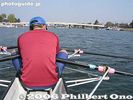
Rowed all the way to Seta Karahashi Bridge and the shinkansen tracks. It was my first time rowing on a competitive rowing boat, and not too difficult even for a beginner.
|
|
|

"Pine trees are very green, on sands very white." Omi-Maiko
|
|

White sands of Omi-Maiko (Omatsu), Otsu, Shiga
|
|

Ripples lap white sands of Omi-Maiko.
|
|

Pine trees at Omi-Maiko
|
|
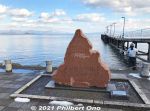
Biwako Shuko no Uta Birthplace Monument, Imazu. This is Imazu's second monument for the song. 全歌詞碑の「琵琶湖周航の歌」誕生の地 今津。今津港。背景には竹生島行きの船。Imazu has two monuments for the song. The first one is a lamp at the end of the pier (visible in this picture on the right of the boat). That was for Verse 3 which is written on the lamp post.
Later in 1994, Imazu town built this red clay monument to commemorate the song's birth in Imazu. The entire lyrics is also engraved. It is next to the Imazu boat pier where boats depart for Chikubushima. Looks like a red flame, but it's shaped after the geographical shape of Imazu town.
|
|

Kyoto University Rowing Club arrive at Omi-Maiko in Aug. 2006 during their annual Lake Biwa rowing trip.
|
|
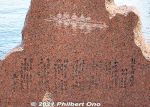
The monument is engraved with the entire song and a picture of rowers.
|
|

Omatsu "Famous Place" marker
|
|

Omatsukan ryokan at Omi-Maiko. This is where Oguchi Taro and rowing mates stayed when they rowed around Lake Biwa. 雄松館
|
|
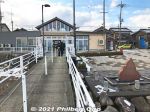
Imazu Port. The song monument is on the right. Looks like a "red fire" as mentioned in the song.From Imazu Port, you can easily go to Chikubushima island by boat, from where you can take another boat to Hikone or Nagahama. Going vice versa is possible too. It's a great way to traverse the lake.
See more photos of Imazu here.
|
|

Song Monument, Imazu. Looks like red fire, but it's also the shape of Imazu town. (The background shows the old Imazu Port building.)Directions: From Omi-Imazu Station on the JR Kosei Line, get out the east exit and walk on the main road toward the lake. You will soon see the Biwako Shuko no Uta Shiryokan song museum on the left. Be sure to visit this museum too. Walk further toward the lake and you will see Imazu Port. Near the water, you can see the "red fire" song monument. On the very end of the pier, and you can see the lamp monument. (The pier might be closed off if there is no boat, so you may have to ask permission to walk on the pier.) Omi-Imazu Station also has a tourist information office where you can obtain directions and a map.
|
|

Song monument at Imazu Port.
|
|
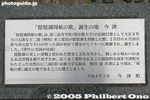
Song Monument plaque, Imazu. It explains about how the song was created in Imazu.
|
|

Imazu Port and song monument in winter snow.
|
|

Chikubushima island and snowly Mt. Ibuki in the background.
|
|
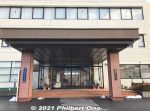
Biwako Shuko no Uta Shiryokan (Lake Biwa Rowing Song Museum) moved to this building's 1st floor and opened on April 1, 2020. This is the Imazu-Higashi Community Center (今津東コミュニティセンター).Right across from the Imazu Shimin Kaikan concert hall.
|
|
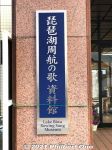
The museum sign includes English! Official English name is "Lake Biwa Rowing Song Museum." 琵琶湖周航の歌資料館
|
|

Entrance to the new Biwako Shuko no Uta Shiryokan (Lake Biwa Rowing Song Museum) in Imazu. 琵琶湖周航の歌資料館
|
|

"On shore, we see red fire"Imazu was where the song was born. The town has two monuments for the song. One is the lamp monument built in 1985 on the boat pier (top photo) for Verse 3 (written on the lamp post), and the other is a red stone monument in the shape of a fire dedicated to the entire song. The lamp monument lights up in red at night. The above image was digitally altered.
|
|
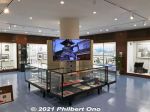
The museum has various panel exhibits, videos, etc. Currently, no explanations in English. Tokiko Kato scored a national hit with the song in 1971.
|
|
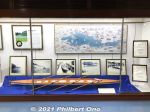
Model of fixed-seat boat used during Oguchi Taro's time in 1917.
|
|

"On shore we see red fire, brings back memories." (Imazu)This is the lake beach at Imazu.
See more photos of Imazu here.
|
|
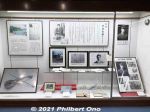
Exhibit for Oguchi Taro who composed the song.
|
|
|
| 1012 files on 5 page(s) |
1 |
 |
 |
|